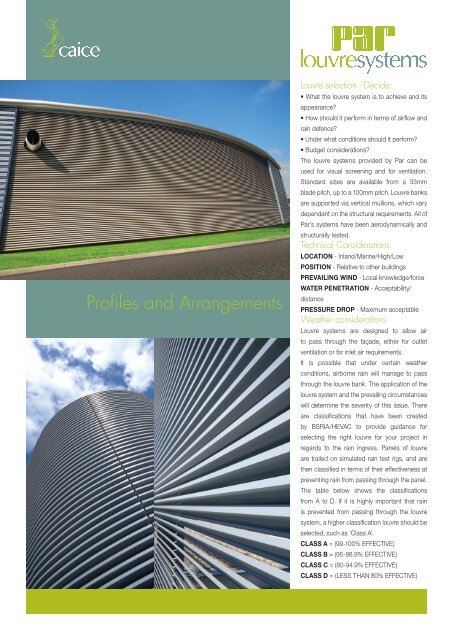Louvre profiles and arrangements data sheet - Caice
Louvre profiles and arrangements data sheet - Caice
Louvre profiles and arrangements data sheet - Caice
You also want an ePaper? Increase the reach of your titles
YUMPU automatically turns print PDFs into web optimized ePapers that Google loves.
Profiles <strong>and</strong> Arrangements<br />
<strong>Louvre</strong> selection - Decide:<br />
• What the louvre system is to achieve <strong>and</strong> its<br />
appearance<br />
• How should it perform in terms of airflow <strong>and</strong><br />
rain defence<br />
• Under what conditions should it perform<br />
• Budget considerations<br />
The louvre systems provided by Par can be<br />
used for visual screening <strong>and</strong> for ventilation.<br />
St<strong>and</strong>ard sizes are available from a 33mm<br />
blade pitch, up to a 100mm pitch. <strong>Louvre</strong> banks<br />
are supported via vertical mullions, which vary<br />
dependant on the structural requirements. All of<br />
Par’s systems have been aerodynamically <strong>and</strong><br />
structurally tested.<br />
Technical Considerations:<br />
LOCATION - Inl<strong>and</strong>/Marine/High/Low<br />
POSITION - Relative to other buildings<br />
PREVAILING WIND - Local knowledge/force<br />
WATER PENETRATION - Acceptability/<br />
distance<br />
PRESSURE DROP - Maximum acceptable<br />
Weather considerations<br />
<strong>Louvre</strong> systems are designed to allow air<br />
to pass through the façade, either for outlet<br />
ventilation or for inlet air requirements.<br />
It is possible that under certain weather<br />
conditions, airborne rain will manage to pass<br />
through the louvre bank. The application of the<br />
louvre system <strong>and</strong> the prevailing circumstances<br />
will determine the severity of this issue. There<br />
are classifications that have been created<br />
by BSRIA/HEVAC to provide guidance for<br />
selecting the right louvre for your project in<br />
regards to the rain ingress. Panels of louvre<br />
are trailed on simulated rain test rigs, <strong>and</strong> are<br />
then classified in terms of their effectiveness at<br />
preventing rain from passing through the panel.<br />
The table below shows the classifications<br />
from A to D. If it is highly important that rain<br />
is prevented from passing through the louvre<br />
system, a higher classification louvre should be<br />
selected, such as ‘Class A’.<br />
CLASS A = (99-100% EFFECTIVE)<br />
CLASS B = (95-98.9% EFFECTIVE)<br />
CLASS C = (80-94.9% EFFECTIVE)<br />
CLASS D = (LESS THAN 80% EFFECTIVE)
<strong>Louvre</strong> Elements <strong>and</strong><br />
Accessories<br />
EXCLUSION GUARDS<br />
• Birdguards (rear mounted mesh <strong>and</strong><br />
between blade grids)<br />
• Insect mesh<br />
• Vermin mesh<br />
• Blanking panels<br />
DOORS<br />
• Single <strong>and</strong> double doors<br />
• Sizes made to order<br />
• Hidden or visible frames<br />
• Ironmongery to suit<br />
FINISHES<br />
• Powder paint finishes<br />
• Anodising<br />
• Custom upon request<br />
SPECIALS<br />
• Mitred corners<br />
• Curved blades<br />
• Geometric shapes <strong>and</strong> circles<br />
• Turrets<br />
Blade Profiles<br />
PLS.100<br />
PLS.50<br />
L.095<br />
L.075<br />
When determining your louvre requirements<br />
please consider the items listed overleaf <strong>and</strong><br />
then contact us to discuss your requirements<br />
in full. Par <strong>Louvre</strong> Systems has designed <strong>and</strong><br />
undertaken hundreds of louvre projects <strong>and</strong> has<br />
an in-depth knowledge of design, application,<br />
aesthetic <strong>and</strong> installation needs. Par <strong>Louvre</strong><br />
Systems can provide either st<strong>and</strong>ard or custom<br />
made solutions for existing or new buildings,<br />
meeting designer’s functional <strong>and</strong> aesthetic<br />
requirements.<br />
Please refer to the <strong>Louvre</strong> Data <strong>sheet</strong>s for the<br />
weathering <strong>and</strong> aerodynamic properties for<br />
each louvre system.<br />
Typical <strong>Louvre</strong> Arrangement For<br />
Ventilation And Screening Applications<br />
• Acoustic louvres<br />
L.066<br />
• Steel louvres<br />
• Timber louvres<br />
INVERTED<br />
TYPICAL<br />
• Glass louvres<br />
<strong>Louvre</strong><br />
Type<br />
PLS 100<br />
PLS 50<br />
HEVAC<br />
Class<br />
B at 0 m/s<br />
B up to 1.0 m/s<br />
L.066.V<br />
L.095 C up to 0 m/s<br />
L.075 C up to 1.0 m/s<br />
L.66 C up to 1.5 m/s<br />
L.66.V<br />
L.033.V<br />
A at 1.0m/s<br />
A at 0 m/s<br />
L.033<br />
L.033.V<br />
L.033 B up to 0.5 m/s<br />
<strong>Louvre</strong> Systems from Par <strong>Louvre</strong> Systems - Bespoke by design.<br />
<strong>Caice</strong> Ltd.<br />
St. Andrews House, St. Andrews<br />
Industrial Est, Bridport, Dorset, DT6 3EX<br />
T: +44 1308 455920 F: +44 1308 425958<br />
info@parlouvres.com www.parlouvres.com
















